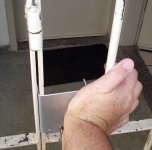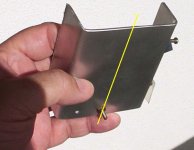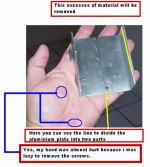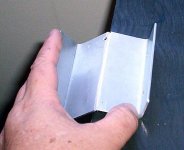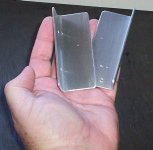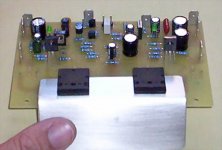What a good new
What a bem novelo !
Maybe you'll be set free to pay transport charge and who know so many more amplifier for sharing music with your neighbors.
We hope for you this unit will be silent as the ocean in a unwindy day.
Have a good day
What a bem novelo !
Maybe you'll be set free to pay transport charge and who know so many more amplifier for sharing music with your neighbors.
We hope for you this unit will be silent as the ocean in a unwindy day.
Have a good day
Precision 1 supply is the same supply used into HRII, the exception will be the...
... condensers insulating voltage that will need to be increased...also the resistance in series with the LEDs..you will need to double the value indicated into the HRII supply schematic, and this schematic is also the same used into the Dx Amplifier.... Greg Home pages has this supply schematic.
.......................................................................................................
You include and exclude C26 and nothing is perceived by your ears, but it works increasing sligtly the swing of voltage as it bypasses the junction resistance of the VBE multiplier transistors...so...upper transistor will receive the same audio voltage swing than the lower one.
Also it behaves, but a very little, as a suck out condenser... as distortions of crossover are generated when the amplifier is entering the threshold of clipping... those charges generated by switching are partially absorbed by the condenser.
But really man!...what a curiosity?
ahahahahahha
regards,
Carlos
... condensers insulating voltage that will need to be increased...also the resistance in series with the LEDs..you will need to double the value indicated into the HRII supply schematic, and this schematic is also the same used into the Dx Amplifier.... Greg Home pages has this supply schematic.
.......................................................................................................
You include and exclude C26 and nothing is perceived by your ears, but it works increasing sligtly the swing of voltage as it bypasses the junction resistance of the VBE multiplier transistors...so...upper transistor will receive the same audio voltage swing than the lower one.
Also it behaves, but a very little, as a suck out condenser... as distortions of crossover are generated when the amplifier is entering the threshold of clipping... those charges generated by switching are partially absorbed by the condenser.
But really man!...what a curiosity?
ahahahahahha
regards,
Carlos
Carlos,
I have an existing amp (Peavey CS800) that I was thinking of rebuilding in the form of a stereo DX Precision 1. The existing amp has +-81V rails... Any chance that I could make the Precision 1 operate on these rails?
Ryan
I have an existing amp (Peavey CS800) that I was thinking of rebuilding in the form of a stereo DX Precision 1. The existing amp has +-81V rails... Any chance that I could make the Precision 1 operate on these rails?
Ryan
The fact that you can do it do not means you should do it
It is a very huge difference of voltage, this means replacement of all capacitors, all electrolitic condenser of higher voltage units, also all transistors will need replacement, including some resistances that will not fit into the board anymore.
A lot of power transistors will be need too.... it is another reality, alike to transform a buggie, a beetle from Volkswagen into a MOPAR.... you will need to change so many things that will result the beetle will not be the beetle anymore.
I have never tried so big voltage into the HRII, so, i really do not know if will sound fine...or the problems will be created by so big energy circulating into tiny boards with tiny copper lines....
More than 500 watts circulating there, more than 10 amperes of audio will produce enormous quantity of eletromagnetic signals that may couple from output to input (for instance)
I really think better idea is to build 6 tiny channels inside your big case, to use, for instance, 50 volts or a little bit more than that, to modify to this voltage and to use power regulators into your 80 volts rails to have them down to 50 volts... this will allow you to have stable rail voltages into 50 volts and will represent even more quality into your sound reproduction.
Each board can be feeded by separated condensers and "insulated" from the other channels voltage variations using diodes, coils, resistances and big condensers...so...you will be able to make a fake 5 supplies, virtually separated one to each other.
You can jump to 100 watts RMS into the HRII... and this in 8 ohms... this power is enougth to every speaker and every home listening position...and having 5 nice channels, that shows very low distortion, with nice audio quality, you will be very happy.
Yes.... and No!
I do not suggest you to do the modification to power HRII with 80 volts..or something big like that.
Yes, i can modify the schematic, customized to you (even knowing that nobody build customized schematics, as people has fear they may explode, as not tested) but will not give you ANY guarantee that will not go away shinning as fireworks... i really DO NOT KNOW if will be stable into this voltage.
I am not a theorical guy.... things i know is because i use to make tests to be sure... and i feel sure only this way.... i imagine it will work fine, but i cannot give you guarantee of that.
I have not time, those last weeks, to assemble and test HRII into this voltage..also i have not this voltage, and to talk frankly, i am not motivated to do that...because scape from the rails, the unit was not created to work this way.... the idea was to sacrifice power to obtain quality...low power...the minimum decent power i could have.... was the idea...not to be too much expensive, to continue reasonable simple and using common, standard parts, easy to find, cheap and reliable..... your idea is against all those things i have planed to HRII.
Have you listened to HRII?.... what have you perceived into it?... what is your evaluation?..... is power increasings your need?
Maybe you wanna use the Peavey chassis and supply.... in this case, if you are a real DIY, transform the huge thing into a variable voltage supply to feed all amplifiers you may build in the future...also to replace the original supply you have in some comercial amplifiers, some supplies not good enougth can be tested if good or not, using a decent huge supply.
Also you can keep your huge amplifier to subwoofer, and if you have appreciated the HRII mids and treble , you can use them to left and rigth full range amplifiers.
Well....you decision Ryan.... those things are up to you... tell me if you wanna a modified schematic and "God Bless you!"
80 volts plus 80 volts can kill us...not a good idea to work under those voltages.
regards,
Carlos
It is a very huge difference of voltage, this means replacement of all capacitors, all electrolitic condenser of higher voltage units, also all transistors will need replacement, including some resistances that will not fit into the board anymore.
A lot of power transistors will be need too.... it is another reality, alike to transform a buggie, a beetle from Volkswagen into a MOPAR.... you will need to change so many things that will result the beetle will not be the beetle anymore.
I have never tried so big voltage into the HRII, so, i really do not know if will sound fine...or the problems will be created by so big energy circulating into tiny boards with tiny copper lines....
More than 500 watts circulating there, more than 10 amperes of audio will produce enormous quantity of eletromagnetic signals that may couple from output to input (for instance)
I really think better idea is to build 6 tiny channels inside your big case, to use, for instance, 50 volts or a little bit more than that, to modify to this voltage and to use power regulators into your 80 volts rails to have them down to 50 volts... this will allow you to have stable rail voltages into 50 volts and will represent even more quality into your sound reproduction.
Each board can be feeded by separated condensers and "insulated" from the other channels voltage variations using diodes, coils, resistances and big condensers...so...you will be able to make a fake 5 supplies, virtually separated one to each other.
You can jump to 100 watts RMS into the HRII... and this in 8 ohms... this power is enougth to every speaker and every home listening position...and having 5 nice channels, that shows very low distortion, with nice audio quality, you will be very happy.
Yes.... and No!
I do not suggest you to do the modification to power HRII with 80 volts..or something big like that.
Yes, i can modify the schematic, customized to you (even knowing that nobody build customized schematics, as people has fear they may explode, as not tested) but will not give you ANY guarantee that will not go away shinning as fireworks... i really DO NOT KNOW if will be stable into this voltage.
I am not a theorical guy.... things i know is because i use to make tests to be sure... and i feel sure only this way.... i imagine it will work fine, but i cannot give you guarantee of that.
I have not time, those last weeks, to assemble and test HRII into this voltage..also i have not this voltage, and to talk frankly, i am not motivated to do that...because scape from the rails, the unit was not created to work this way.... the idea was to sacrifice power to obtain quality...low power...the minimum decent power i could have.... was the idea...not to be too much expensive, to continue reasonable simple and using common, standard parts, easy to find, cheap and reliable..... your idea is against all those things i have planed to HRII.
Have you listened to HRII?.... what have you perceived into it?... what is your evaluation?..... is power increasings your need?
Maybe you wanna use the Peavey chassis and supply.... in this case, if you are a real DIY, transform the huge thing into a variable voltage supply to feed all amplifiers you may build in the future...also to replace the original supply you have in some comercial amplifiers, some supplies not good enougth can be tested if good or not, using a decent huge supply.
Also you can keep your huge amplifier to subwoofer, and if you have appreciated the HRII mids and treble , you can use them to left and rigth full range amplifiers.
Well....you decision Ryan.... those things are up to you... tell me if you wanna a modified schematic and "God Bless you!"
80 volts plus 80 volts can kill us...not a good idea to work under those voltages.
regards,
Carlos
Carlos,
Thanks for the detailed response. As you suggested, I am interested in making use of the existing transformer and chassis (The most expensive parts of the build). Perhaps, as you suggest, regulating the rails down to something more reasonable like 50 or 60 volts would be a better approach. It just seems like such a waste to cut the power down... But I agree, nobody in there right mind needs 1000W rms in a home stereo system.
I have not heard the HRII... I'm sure it has plenty of power. And the Precision has even more. Anything designed for +-65V is sufficient to get me evicted.
Thanks for the detailed response. As you suggested, I am interested in making use of the existing transformer and chassis (The most expensive parts of the build). Perhaps, as you suggest, regulating the rails down to something more reasonable like 50 or 60 volts would be a better approach. It just seems like such a waste to cut the power down... But I agree, nobody in there right mind needs 1000W rms in a home stereo system.
I have not heard the HRII... I'm sure it has plenty of power. And the Precision has even more. Anything designed for +-65V is sufficient to get me evicted.
I am sorry... i am old and stupid...you made question about the Precision 1
I think this one can hold the power...but not guaranteed too.
Was made to higher voltage (63V)... so...may work fine into 80 volts too.
If you wanna do that....go ahead and good luck.
Better is to go down with your voltage, to 64 volts for instance, and you will have a very stable supply to use into the Precision 1.... was tested, into 64 volts it is very guaranteed.
regards,
Carlos
I think this one can hold the power...but not guaranteed too.
Was made to higher voltage (63V)... so...may work fine into 80 volts too.
If you wanna do that....go ahead and good luck.
Better is to go down with your voltage, to 64 volts for instance, and you will have a very stable supply to use into the Precision 1.... was tested, into 64 volts it is very guaranteed.
regards,
Carlos
My thoughts as well, P1 may be overkill for driving the tweeters etc... HRII has awesome top end and will fit that gap perfectly...
Re: Precision 1 supply is the same supply used into HRII, the exception will be the..
Ok, thanks. Put my name in GB list.
Regards.
JC
destroyer X said:... condensers insulating voltage that will need to be increased...also the resistance in series with the LEDs..you will need to double the value indicated into the HRII supply schematic, and this schematic is also the same used into the Dx Amplifier.... Greg Home pages has this supply schematic.
regards,
Carlos
Ok, thanks. Put my name in GB list.
Regards.
JC
Please, go to Nordic group buy...he is making that registration
Thank you very much Fardo.
regards,
Carlos
Thank you very much Fardo.
regards,
Carlos
Re: I am sorry... i am old and stupid...you made question about the Precision 1
What is the best way to regulate/reduce 80v down to 64v Carlos? I have the same situation with my 75vdc Bryston chassis. I think Precision I will be okay with 70-75, but regulating or reducing it downward a little has its appeal too.
Ryan, it must be a Vancouver thing to recycle old PA amp chassis. If you decide not to push the Precision I circuit to 81v rails, Quasi's Actrk400 amplifier is designed for these high power supplies. http://www.adam.com.au/cgpap/QuasiWeb/index.htm
Sorry Carlos, I hope you don't mind the alternative direction advice.
..Todd
destroyer X said:
Better is to go down with your voltage, to 64 volts for instance, and you will have a very stable supply to use into the Precision 1.... was tested, into 64 volts it is very guaranteed.
What is the best way to regulate/reduce 80v down to 64v Carlos? I have the same situation with my 75vdc Bryston chassis. I think Precision I will be okay with 70-75, but regulating or reducing it downward a little has its appeal too.
Ryan, it must be a Vancouver thing to recycle old PA amp chassis. If you decide not to push the Precision I circuit to 81v rails, Quasi's Actrk400 amplifier is designed for these high power supplies. http://www.adam.com.au/cgpap/QuasiWeb/index.htm
Sorry Carlos, I hope you don't mind the alternative direction advice.
..Todd
No problems dear Todd..... i will show how to transform a single
"L" shape plate into two smaller "L" shape plates.
Very easy and very DIY.
I have found a neighboor gate that has small gap..something strong to hold the aluminium into place, and then applying force you bend.
Observe images...they show clearly.
I had one "L" shape.... now i have an "U" shape that splitted will be two smaller "L" shapes once again.
regards,
Carlos
"L" shape plate into two smaller "L" shape plates.
Very easy and very DIY.
I have found a neighboor gate that has small gap..something strong to hold the aluminium into place, and then applying force you bend.
Observe images...they show clearly.
I had one "L" shape.... now i have an "U" shape that splitted will be two smaller "L" shapes once again.
regards,
Carlos
Attachments
Here, now splitted in two parts.... of course
not big enougth.... very small, will not transfer very good the heat to the heatsink..because the "L" long leg has not too much area of contact...the transistor is using all it's contact area..but would be better to be into the center of the aluminium...and this impeaches to use the "L" shape that is very, very, elegant.
But for moderated, reasonable, normal auditioning volumes, using an amplifier alike the Dx Standard, with maximum 50 watts and normal audition into 10 watts RMS..then you will not have problems with the size.
regards,
Carlos
not big enougth.... very small, will not transfer very good the heat to the heatsink..because the "L" long leg has not too much area of contact...the transistor is using all it's contact area..but would be better to be into the center of the aluminium...and this impeaches to use the "L" shape that is very, very, elegant.
But for moderated, reasonable, normal auditioning volumes, using an amplifier alike the Dx Standard, with maximum 50 watts and normal audition into 10 watts RMS..then you will not have problems with the size.
regards,
Carlos
Attachments
Here is a Super amplifier, a demonstration board, a prototype that will never return
to the sender..... no way!.... absolutelly no way to sent it back.
This top secret amplifier, wonderfull prototype that was not even aproved by the Master of the Designers, sounds wonderfull and now a days it is MINE!
You see, the blade is not big enougth, but can be used if you maintain the power into low levels.
The man, the one that made this board, even prototype without silk screen is the King of elegance.
regards,
Carlos
to the sender..... no way!.... absolutelly no way to sent it back.
This top secret amplifier, wonderfull prototype that was not even aproved by the Master of the Designers, sounds wonderfull and now a days it is MINE!
You see, the blade is not big enougth, but can be used if you maintain the power into low levels.
The man, the one that made this board, even prototype without silk screen is the King of elegance.
regards,
Carlos
Attachments
Hi Carlos,
You missed my question:
"What is the best way to regulate/reduce 80v down to 64v Carlos? I have the same situation with my 75vdc Bryston chassis. I think Precision I will be okay with 70-75, but regulating or reducing it downward a little has its appeal too. "
Any advice for that?
..Todd
You missed my question:
"What is the best way to regulate/reduce 80v down to 64v Carlos? I have the same situation with my 75vdc Bryston chassis. I think Precision I will be okay with 70-75, but regulating or reducing it downward a little has its appeal too. "
Any advice for that?
..Todd
- Status
- Not open for further replies.
- Home
- Amplifiers
- Solid State
- Dx Precision, finally released... now debugged and better than HRII
